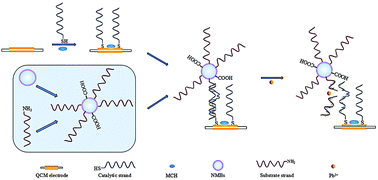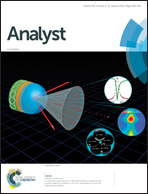QCM-nanomagnetic beads biosensor for lead ion detection
Abstract
As lead poses a serious threat to humans even in small amounts, all kinds of lead detection sensors with high sensitivity and selectivity are being constantly improved and put forward. In this report, a novel, simple and label-free quartz crystal microbalance (QCM) biosensor is proposed for detecting lead ions (Pb2+). The biosensor takes full advantage of the high specificity of GR-5 DNAzyme to Pb2+ and the high sensitivity of QCM. In particular, nanomagnetic beads (NMBs) are used as a novel and effective mean of signal amplification in the biosensor because of their mass and their ability to enhance the inductive effect, which are very beneficial for both higher sensitivity and a lower detection limit. In practice, GR-5 DNAzyme, innovatively combined with NMBs, was modified on the gold electrode of the QCM through gold–sulfur self-assembly. When the electrode was exposed to Pb2+ solution, DNAzyme was severed into two parts at the RNA site (rA), along with the release of NMBs, which caused a great increase in frequency shift of the QCM electrode. Finally, a perfect linear correlation between the logarithm of Pb2+ concentration and the change in frequency was obtained from 1 pM to 50 nM, with a detection limit as low as 0.3 pM. Moreover, the biosensor shows both an average recovery of 97 ± 6% in a drinking water sample and an excellent specificity for Pb2+ compared with other metal ions.



 Please wait while we load your content...
Please wait while we load your content...